1. Electron Microscopy Laboratory:
1.1.
Scanning Electron Microscopy coupled with Energy Dispersive X-ray (SEM/EDX) Spectroscopy
Nova Nano SEM 450 and Quanta 200 SEM
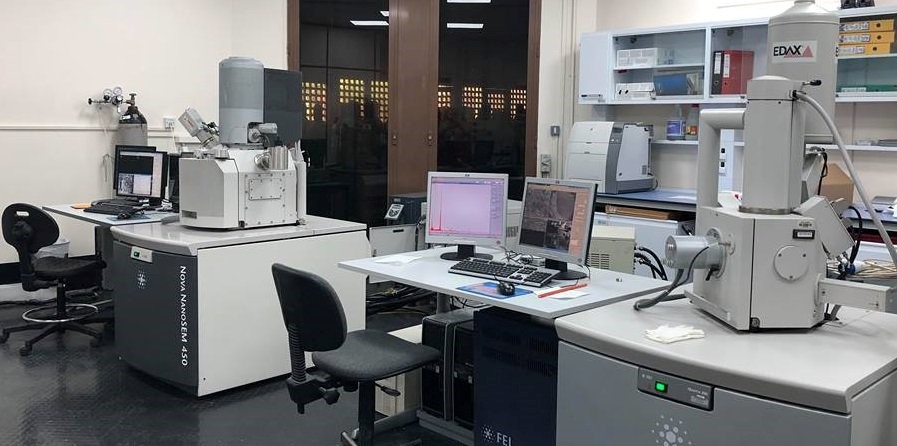
In scanning electron microscopy (SEM), a highly energetic and focused electron beam scans the sample and normally provides an extremely enlarged image of the morphology of the sample, as well as information on its chemical composition using an energy dispersive spectrometer (EDS) detector. SEM-EDS is mainly used for the characterization of materials, but lately, its application has been extended to study organic-based specimens.
1.1.1.
Applications:
- Detection and analysis of surface fractures.
- Examination of surface contaminations.
- Providing information in the microstructure.
- Revelations of spatial variations in chemical compositions.
- Wide applications in life science, biology, gemology, medical, forensic science, and metallurgy.
Instrument |
Manufacture |
Model |
Location |
Person in charge |
Nova Nano Scanning Electron Microscopy with Bruker EDX Detector |
FEI |
Nova Nano SEM 450 |
BCR Building - Corridor 4 - D114 | Mr. Essam Shabaan Mohamed Attia Senior Chemist Email:
e.attia@qu.edu.qa Phone No
4403-3937 |
Quanta 200 Environmental Scanning Electron Microscope (ESEM) with EDAX-EDS |
FEI |
FEI Quanta 200 ESEM |
BCR Building - Corridor 4 - D114 |
1.2.
Transmission Electron Microscopy (TEM)
FEI TECNAI G2 TEM, TF20
.jpg)
TEM Microscopy technique whereby a beam of electrons is transmitted through an ultra-thin specimen, interacting with the specimen of the electrons transmitted through the specimen; the image is magnified and focused onto an imaging device, such as a fluorescent screen, on a layer of photographic film, or to be detected by a sensor such as s CCD camera.
1.2.1.
Applications:
- Different fields such as life sciences, nanotechnology, medical, biological, and material research, forensic analysis, gemology, and metallurgy as well as industry and education.
- TEM provides topographical, morphological, compositional, and crystalline information.
Instrument |
Manufacture |
Model |
Location |
Person in charge |
Transmission Electron Microscope (TEM)
|
FEI |
TECNAI G2 TEM, TF20 |
BCR Building - Corridor 4 - D113 | Mr. Nandagopal Sivadas Pothuvattil Research Assistant
Email:
npothuvattil@qu.edu.qa Phone No:
4403-3938 |
2. Elemental Analysis Laboratory
2.1.
Elemental Analyzer (CHNS/O)
Flash 2000 Elemental Analyzer (CHNS/O)
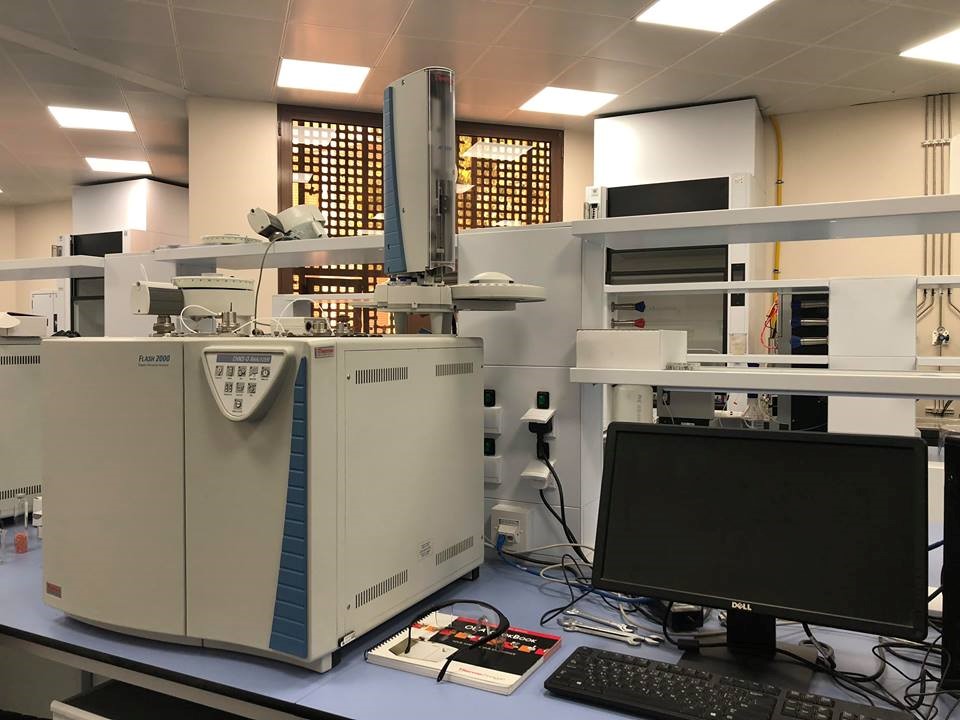
The analyzer is a combustion technique that determines the weight of percent carbon, hydrogen, sulfur, or oxygen in a variety of sample types.
2.1.1.
Applications:
- Organic, Inorganic chemistry and Pharmaceutical
- Material Characterization
- Environmental Analysis
- Agronomy and Marine Science
- Petro Chemistry and Energy
- Human and animal sample
- Isotopic analyses.
Instrument |
Manufacture |
Model |
Location |
Person in charge |
CHNS % Organic Elemental Analyzer |
Thermo Fisher |
Flash 2000 |
BCR Building - Corridor 3 - C113 | Dr. Ahmed Easa
Lab Technician Email:
ahmedaali@qu.edu.qa Phone No:
4403 6782 |
% NC Soil Elemental Analyzer |
Thermo Fisher |
Flash 2000 |
BCR Building - Corridor 3 - C113 |
2.2.
TOC/TN Analyzer
TOC/TN Analyzer Skalar Primacs MCS - Formacs CA16

TOC is an indirect measure of organic molecules present in water and measured as carbon. One approach used to measure TOC involves subtracting the measured inorganic carbon (IC) from the measured total carbon (TC).
2.2.1.
Applications:
- Drinking water • Wastewater
- Surface water • Seawater
- High saline waters • Process control
- Pharmaceutical industry • Soil extracts
Instrument |
Manufacture |
Model |
Location |
Person in charge |
Total Organic Carbon/Total Nitrogen Analyzer |
Skalar |
Primacs MCS - Formacs CA16 |
BCR Building - Corridor 3 - C113 | Dr. Ahmed Easa Lab Technician Email:
ahmedaali@qu.edu.qa Phone No:
4403 6782 |
3.Thermal Analysis Laboratory
3.1.
Thermo Gravimetric Analyzer (TGA)
TGA Perkin Elmer Pyris 6 TGA
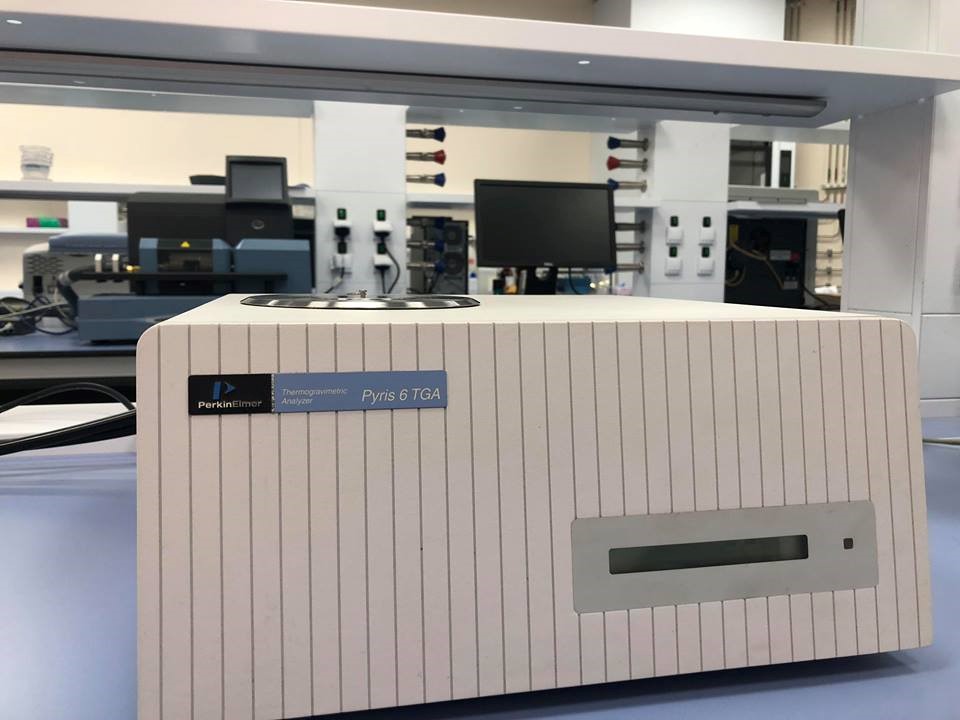
A technique in which the mass of the sample is monitored against time or temperature while the temperature of the sample, in a specified atmosphere.
3.1.1.
Application:
- Ceramic application
- Metal material application
- Carbon capture
- Polymer application
- Pharmaceuticals
- Food
Instrument |
Manufacture |
Model |
Location |
Person in charge |
Thermogravimetric Analyzer (TGA) |
PerkinElmer |
Pyris 6 TGA |
BCR Building - Corridor 4 - D117 | Ms. Muneera Al-Qahtani Senior Lab Technician Email: mualqahtani@qu.edu.qa Phone No:
4403 3935 |
3.2.
Differential Scanning Calorimeter (DSC)
(DSC) Perkin Elmer Jade DSC
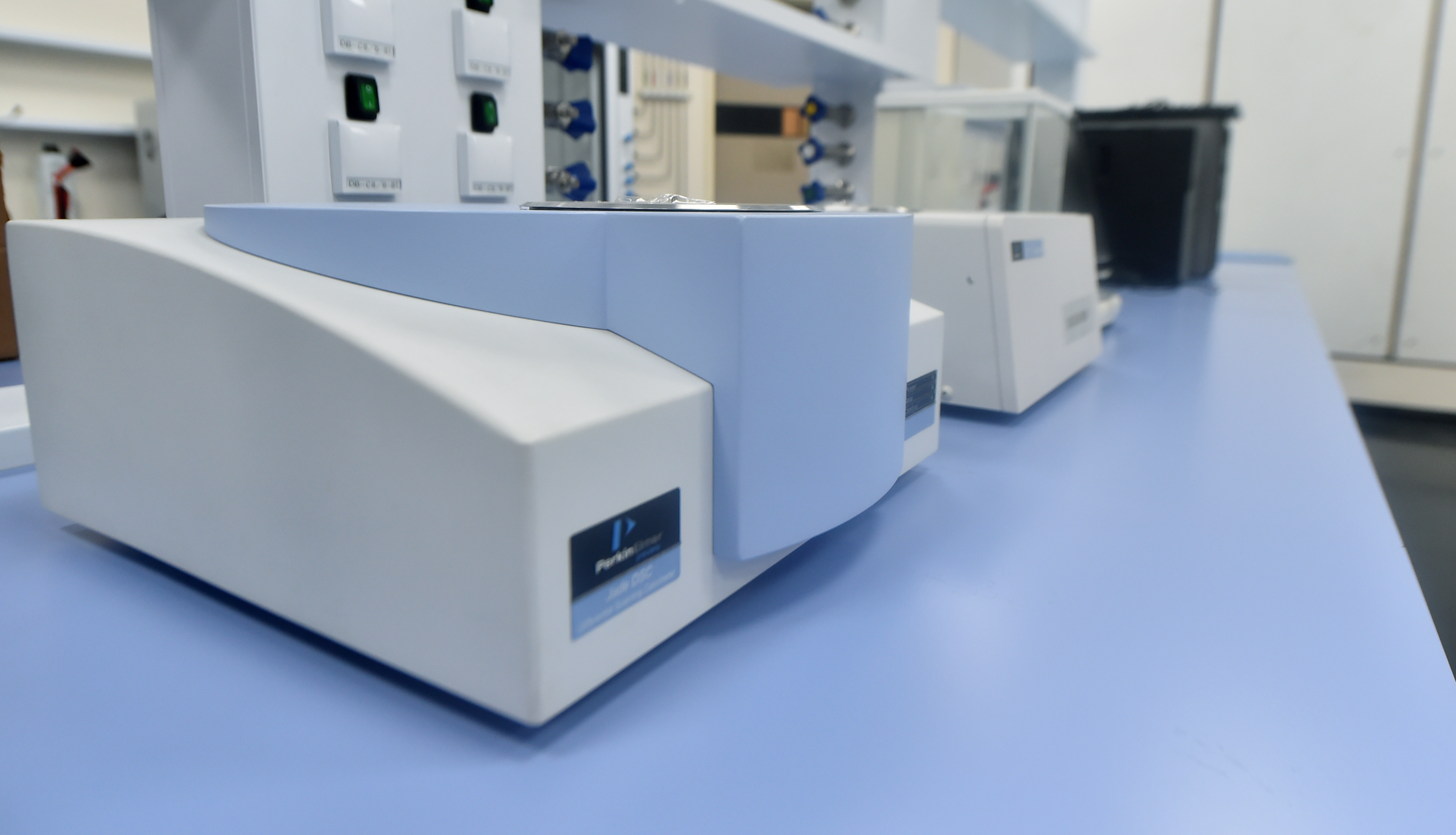
DSC is a thermos analytical technique used to study the thermal properties of the polymer using a differential scanning calorimeter. In this process, the difference for the heat required to increase the temperature of a sample and reference is measured as a function of temperature.
3.2.1.
Application:
- DSC used in the study of liquid crystals
- The study of the stability to oxidation of samples.
- Used in the pharmaceutical and polymer industries.
- Examination of polymers to check their composition.
Instrument |
Manufacture |
model |
Location |
Person in charge |
Differential Scanning Calorimeter (DSC) |
PerkinElmer |
Jade DSC |
BCR Building - Corridor 4 - D117 | Ms. Muneera Al-Qahtani Senior Lab Technician Email: mualqahtani@qu.edu.qa Phone No:
4403 3935 |
3.3.
Thermogravimetric Analysis/Mass Spectrometry (TGA-MS) (TGA-MS) :
(TGA-MS) TA SDTQ600
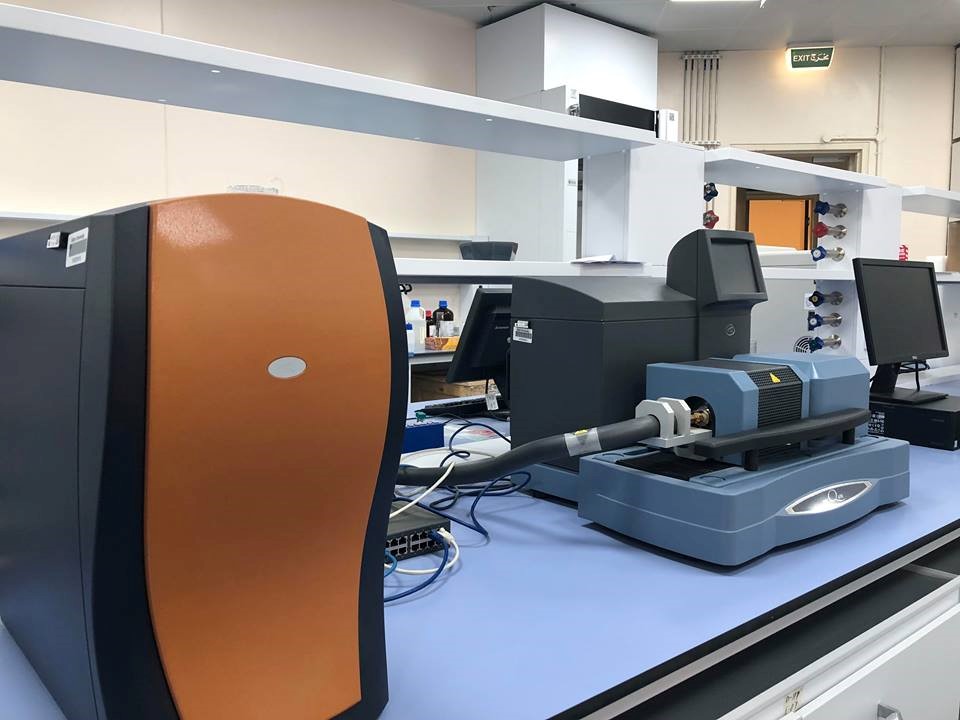
Is a powerful technique that has been used for to characterize solid and liquid sample. Additional information about sample composition and thermal behavior can be obtained by analyzing the gases that leave the material as it is heated.
3.3.1.
Applications:
- Ceramic application
- Metal material application
- Carbon capture
- Polymer application
- Pharmaceuticals
- Food analysis
Instrument |
Manufacture |
Model |
Location |
Person in charge |
Thermo Gravimetric Analyzer with Mass Spectrometry (TGA- MS) |
TA |
SDTQ600 |
BCR Building - Corridor 4 - D117 | Ms. Muneera Al-Qahtani Senior Lab Technician Email: mualqahtani@qu.edu.qa Phone No:
4403 3935 |
4. Molecular Spectroscopy Laboratory
4.1.
Ultraviolet / Visible Spectrometer
(UV/VIS) Spectrometer, Lambda 25
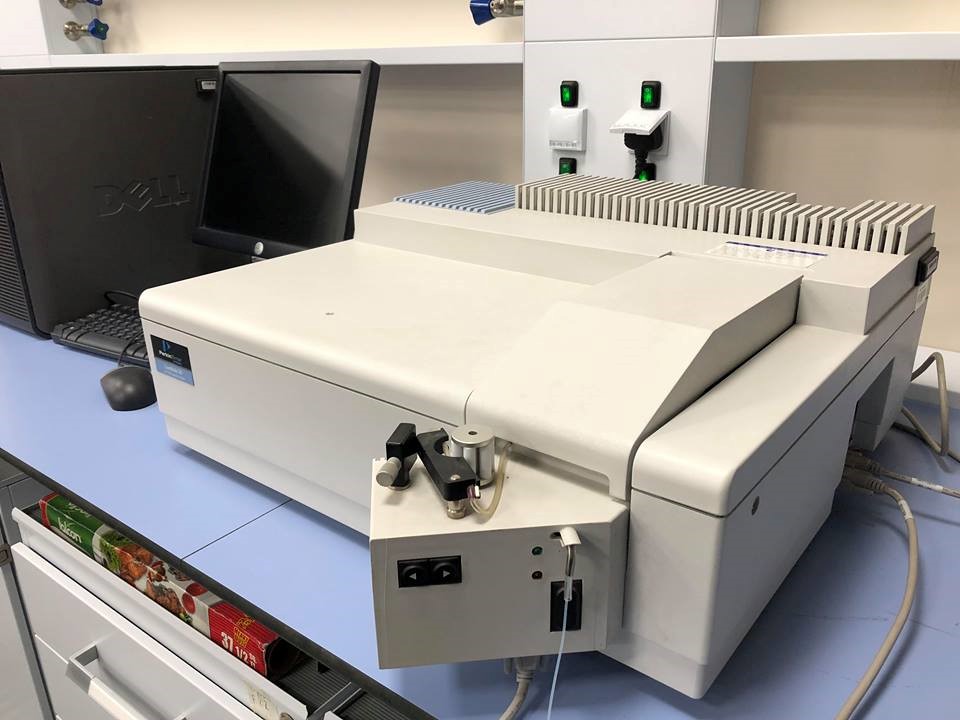
Ultraviolet and Visible Spectrometer is used to measure the intensity of light, and the intensity is proportional to the wavelength. UV is routinely used in analytical chemistry for the quantitative determination of different analyses.
4.1.1.
Applications:
- Detection of the functional group.
- Detection of the extent of conjugation.
- Identification of an unknown compound.
- Determination of configurations of geometrical isomers.
- Determination of the purity of a substance.
Instrument |
Manufacture |
Model |
Location |
Person in charge |
Ultraviolet-Visible (UV/VIS) Spectrometer |
PerkinElmer |
Lambda 25 |
BCR Building - Corridor 3 - C113 | Eng. Sherin Abdel Fatah Mohammed Lab Technician Email:
Sherin.a@qu.edu.qa Phone No:
4403 3936 |
4.2.
FTIR Spectrometer
FTIR Spectrometer, Spectrum 400 Perkin Elmer
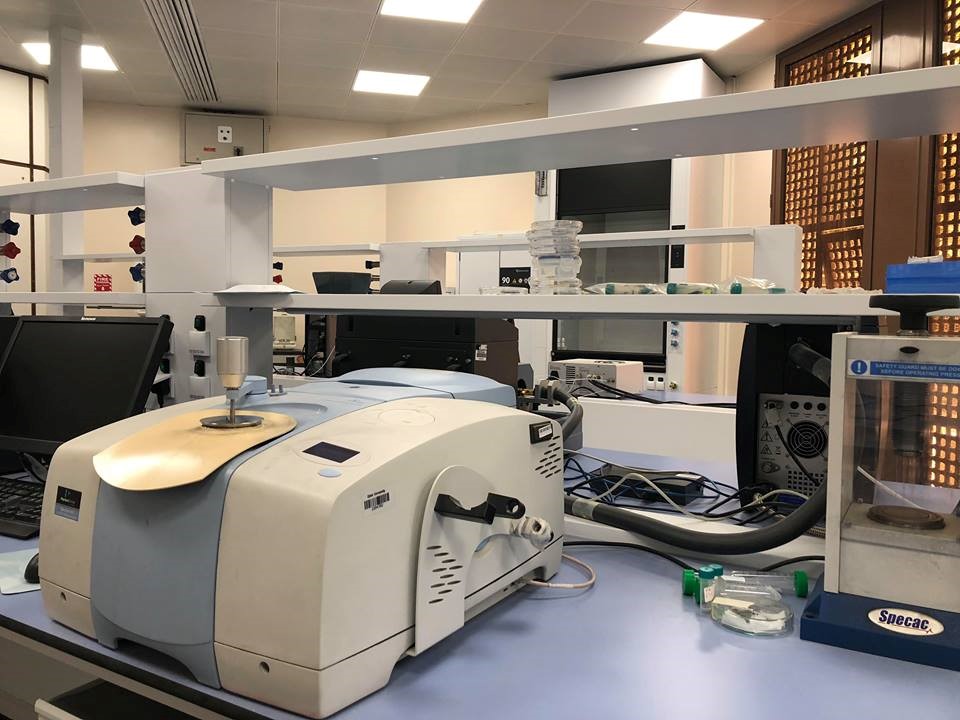
FTIR Spectrometer Is a technique used to obtain an infrared spectrum of absorption or emission of a solid, liquid, or gas. An FTIR spectrometer simultaneously collects high-spectral-resolution data over a wide spectral range. This confers a significant advantage over a dispersive spectrometer, which measures intensity over a narrow range of wavelengths at a time.
4.2.1.
Applications:
- Materials Analysis • Forensics
- Pharmaceuticals • Biomedical Research
-
Academic Research • Biomaterials
Instrument |
Manufacture |
Model |
Location |
Person in charge |
Fourier Transform Infrared Spectroscopy (FTIR-NIR) |
PerkinElmer |
Spectrum 400 |
BCR Building - Corridor 4 - D117 | Ms. Muneera Al-Qahtani Senior Lab Technician Email mualqahtani@qu.edu.qa Phone No:
4403 3935 |
4.3. Raman Spectrometer
Raman Thermo Scientific DXR3
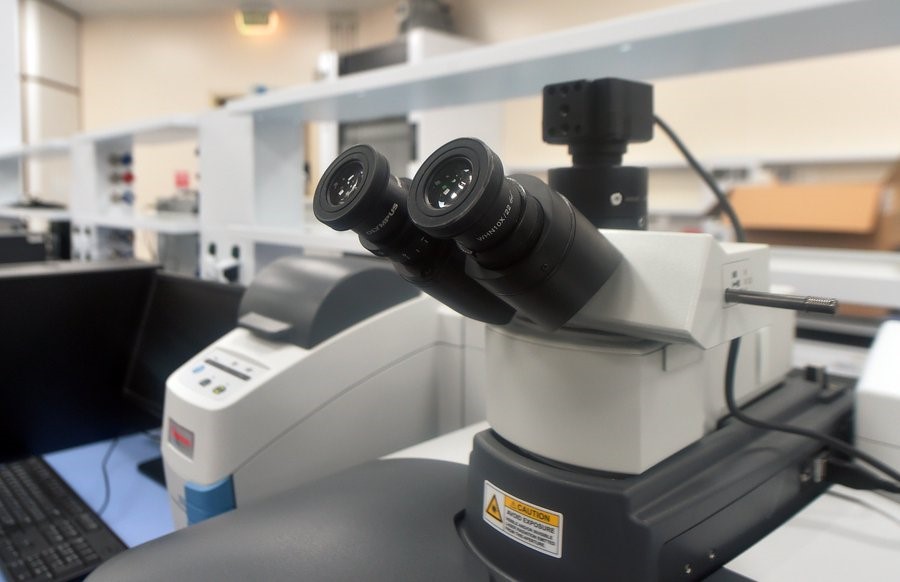
Raman Spectrometer is one of the vibrational spectroscopic techniques used to provide information about molecular vibrations that can be used for sample identification and quantitation. This technique uses a laser light source to irradiate a sample and generates an infinitesimal amount of Raman scattered light, which is detected as a Raman spectrum using a CCD camera.
4.3.1. Applications
- Measurement of stress.
- Measurement of mid-range order of solid.
- The water content of silicate glasses and minerals.
- Phase transition and order-disorder transitions in minerals.
- Speciation of water in glasses.
Instrument |
Manufacture |
Model |
Location |
Person in charge |
Raman Microscope |
Thermo Fisher |
DXR Dispersive Raman |
BCR Building - Corridor 3 - C113 |
Eng. Sherin Abdel Fatah Lab Technician
Sherin.a@qu.edu.qa
4403 3936 |
5. Chromatography Laboratory
5.1.
Ion Chromatography (IC)
Metrohm 850 Professional IC
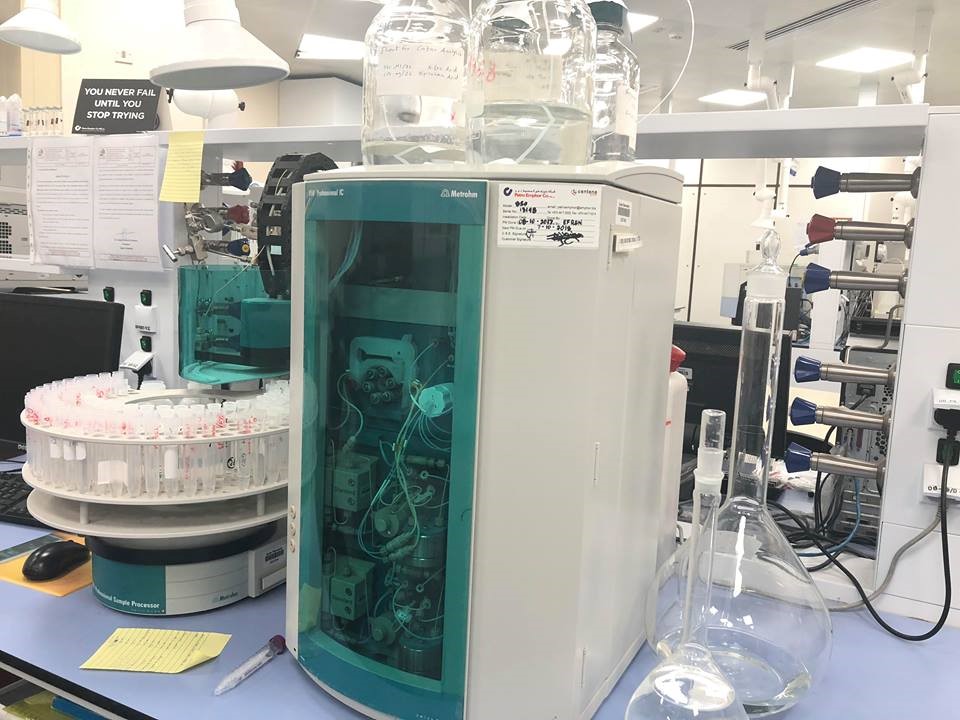
Ion chromatography (or ion-exchange chromatography) separates ions and polar molecules based on their affinity to the ion exchanger. It works on almost any kind of charged molecule. The ion chromatography in the Central Laboratories Unit can analyze Anions (Fluoride, Chloride, Bromide, Nitrate, Phosphate, Sulfate) and for cations (Lithium, Sodium, Ammonium, Potassium, Calcium, Magnesium).
5.1.1.
Applications
- Determination of cations and anions
- Drinking water analysis
- Process water analysis
- Waste water analysis
- Extracts
- Digested solutions
- Diluted fruit and vegetable juice analysis
Instrument |
Manufacture |
Model |
Location |
Person in charge |
Ion Chromatography (IC) |
Metrohm |
850 Professional IC |
BCR Building - Corridor 3 - C114 |
Mr. Ahmad Ali Ahmadi Chemist
aahmadi@qu.edu.qa
4403 6614 |
Mr. Mohammed Akkbik Senior Lab Technician
m.akkbik@qu.edu.qa |
5.2.
Ultra-performance liquid chromatography (UPLC)
UPLC Waters Acquity
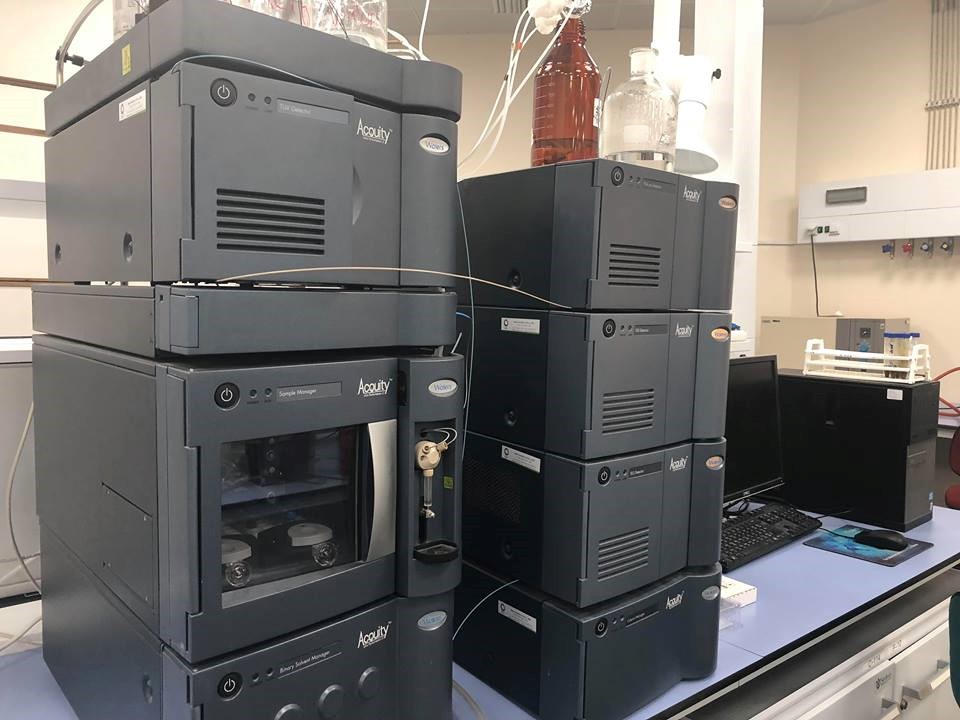
UPLC is a technique in analytical chemistry used to separate, identify, and quantify organic components in a mixture. Chromatography can be described as a mass transfer process involving adsorption. HPLC relies on pumps to pass a pressurized liquid and a sample mixture through a column filled with adsorbent, leading to the separation of the sample components. Detectors used of the UPLC in CLU are Ultra Violate Detector (TUV), Photo Diode Array Detector (PDA), Fluorescence Detector (FLD), and Evaporative Light Scattering Detector (ELSD).
5.2.1.
Applications
- Determination of Pesticides in Groundwater.
- Multi-Residue Analysis of Pharmaceuticals in Waste Water.
- Analysis of Contaminants in Foodstuffs.
- During the drug development process, toxicity issue causes a fall out of drug candidates and this causes monetary loss to the organization.
Instrument |
Manufacture |
Model |
Location |
Person in charge |
Ultra Performance Liquid Chromatography (UPLC) |
Waters |
Acquity |
BCR Building - Corridor 3 - C114 |
Mr. Ahmad Ali Ahmadi Chemist
aahmadi@qu.edu.qa
4403 6614 |
Mr. Mohammed Akkbik Senior Lab Technician
m.akkbik@qu.edu.qa |
5.3.
Liquid chromatography Tandom Mass LC-MS/MS
(LC-MS/MS) Agilent Technologies 6460
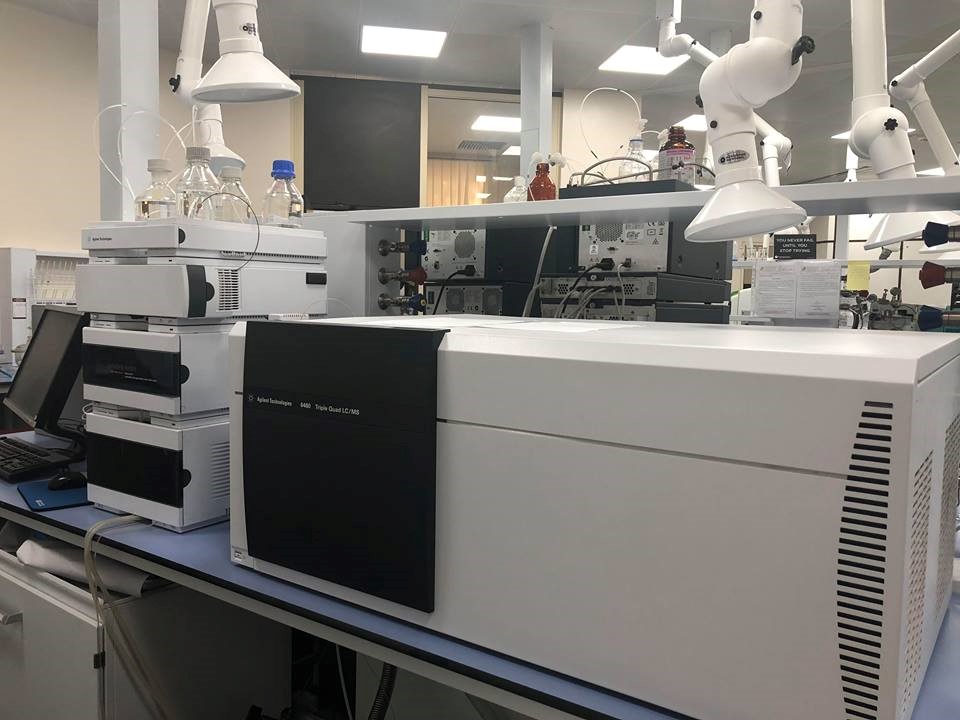
Liquid chromatography-mass spectrometry (LC-MS/MS) is an analytical chemistry technique that combines the physical separation capabilities of liquid chromatography or HPLC with the mass analysis capabilities of mass spectrometry (MS). Coupled chromatography - MS systems are popular in chemical analysis because the individual capabilities of each technique are enhanced synergistically. Wide applications are capable of the LC-MS/MS, which can analyze samples with high detection sensitivity.
5.3.1.
Applications
- Biomedical Applications.
- Environmental Applications.
- Biochemical Screening for Genetic Disorders.
- Pharmaceuticals.
- Therapeutic Drug Monitoring and Toxicology.
- Vitamins and Related Metabolites.
Instrument |
Manufacture |
Model |
Location |
Person in charge |
Liquid Chromatography Tandom Mass LC-MS/MS |
Agilent |
Agilent Technologies 6460 |
BCR Building - Corridor 3 - C114 |
Mr. Ahmad Ali Ahmadi Chemist
aahmadi@qu.edu.qa
4403 6614 |
Mr. Mohammed Akkbik Senior Lab Technician
m.akkbik@qu.edu.qa |
5.4.
Gas Chromatography (GC-FID)
Clarus 680 Gas Chromatography- PerkinElmer
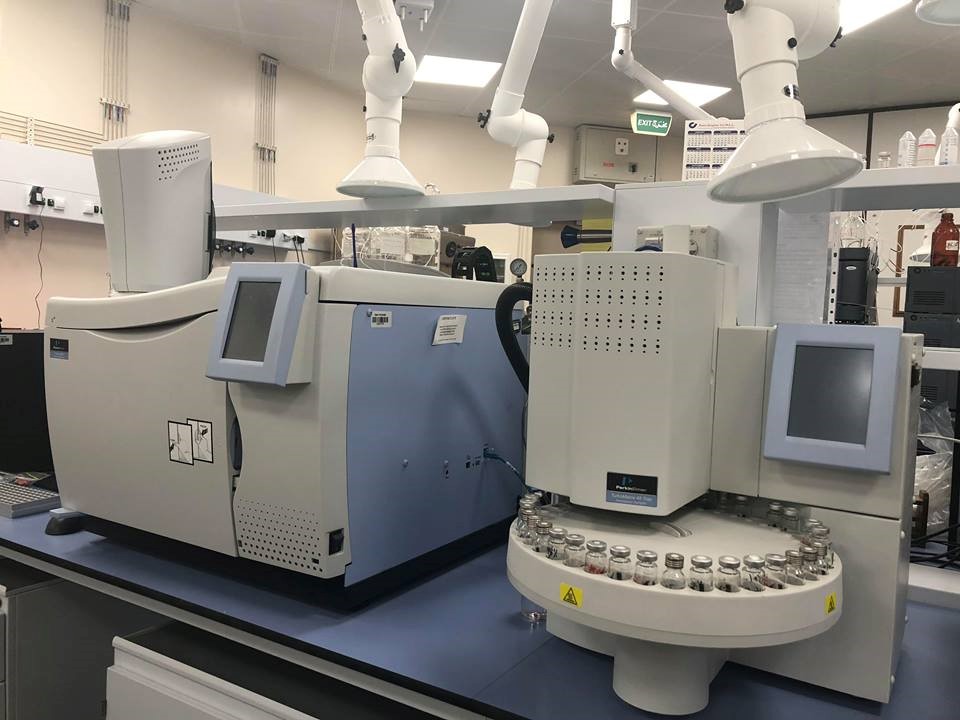
Gas Chromatography with a Flame ionization detector (GC-FID) is one of the most important instruments. Ionization detectors interact with solutes eluted from gas chromatography (GC) columns to produce a current that varies in proportion to the amount of solute present. FID is sensitive to molecules that are ionized in a hydrogen–air flame, including most carbon-containing compounds.
5.4.1.
Applications
- Miscellaneous –analysis of food like carbohydrates, proteins, Lipids, Vitamins, steroids, drugs, and pesticides residues, trace elements.
- Pollutants like formaldehyde, carbon monoxide, benzene, DDT.
- Inorganic compound analysis.
- Separation and identification of volatile materials, Plastics, natural and synthetic polymers, paints, and microbiological samples.
Instrument |
Manufacture |
Model |
Location |
Person in charge |
Gas Chromatography (GC) |
PerkinElmer |
Clarus 680 Gas Chromatography |
BCR Building - Corridor 3 - C116 |
Mr. Ahmad Ali Ahmadi Chemist
aahmadi@qu.edu.qa
4403 6614 |
Mr. Mohammed Akkbik Senior Lab Technician
m.akkbik@qu.edu.qa |
6. Atomic Spectroscopy Laboratory
6.1.
Inductively Coupled Plasma/ Mass Spectrometer (ICP/MS):
ICP – MS PerkinElmer- NexIon 300 D
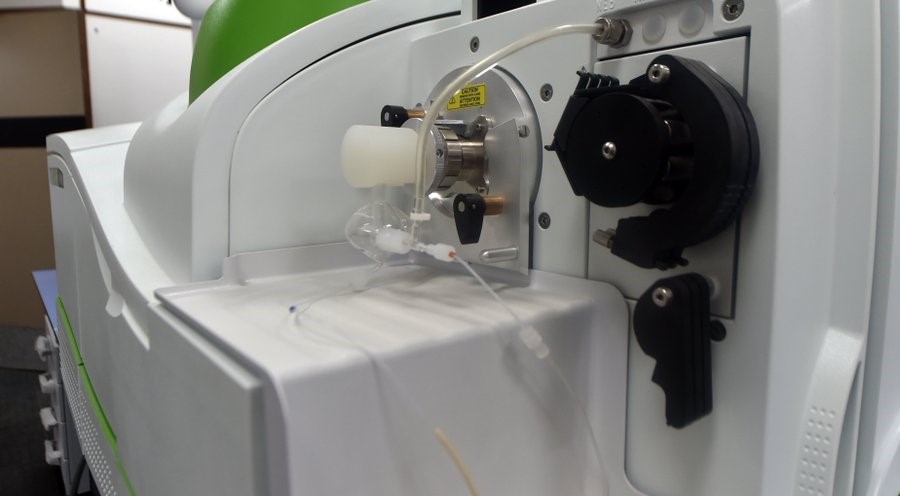
Inductively coupled plasma mass spectrometry (ICP-MS) is a type of mass spectrometry that uses inductively coupled plasma to ionize the sample. It atomizes the sample and creates atomic and small polyatomic ions, which are then detected. It is known and used for its ability to detect metals and several non-metals in liquid samples at very low concentrations. It can detect different isotopes of the same element, which makes it a versatile tool in isotopic labeling.
6.1.1.
Applications
- Water and wastewater treatment measurements,
- Medical and forensic field, specifically, toxicology.
- Geochemistry field for radiometric dating, in which for analyze the relative abundance of different isotopes.
- Detecting inorganic impurities in pharmaceuticals.
- Metal and semi-metal analysis in deionized water, chemicals, and on the wafer surface.
- The applications include Environmental – Foods – Semiconductor – Clinical – Chemical/Petrochemical – Pharmaceutical – Consumer Goods – Forensic – Geological – Nuclear – Academic/Research
Instrument |
Manufacture |
Model |
Location |
Person in charge |
Inductively Coupled Plasma Mass Spectrometry (ICP-MS)
and Laser Ablation |
PerkinElmer |
NexIon 300 D |
BCR Building - Corridor 4 - D116 |
Dr. Mohammad Ibrahim Ahmad Research Associate
Mohammad.ibrahim@qu.edu.qa
4403 5716 |
Mr. Mohammad Sulaiman Lab Technician
msulaiman@qu.edu.qa 4403 3919 |
6.2.
Inductively Coupled Plasma - Optical Emission (ICP- OES)
ICP-OES PerkinElmer Optima 7300 DV
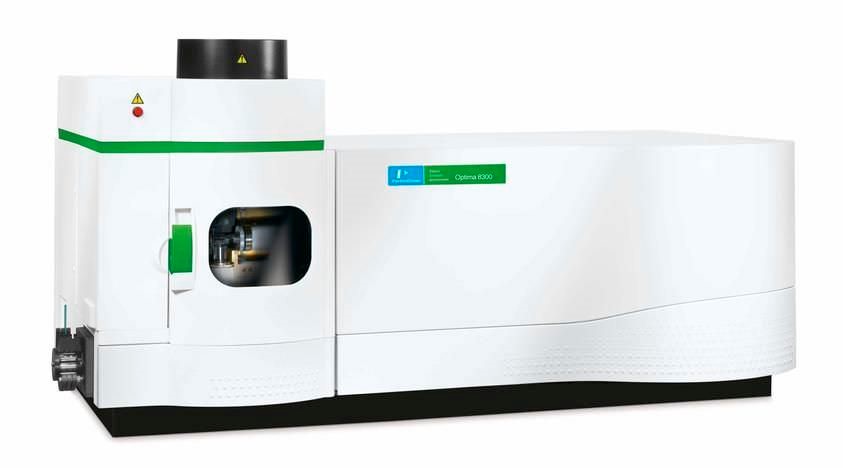
Inductively Coupled Plasma Optical Emission Spectroscopy (ICP-OES) is an analytical technique used to determine how much certain elements are in a sample. The ICP-OES principle uses the fact that atoms and ions can absorb energy to move electrons from the ground state to an excited state.
6.2.1 Applications
- Soil, sediment, rocks, minerals, air analysis
- Geochemistry researches
- Mineralogical analysis
- Agricultural analysis
- Forestry analysis
- Forensics analysis
- Environmental sciences measurements
- Food industry
Instrument |
Manufacture |
Model |
Location |
Person in charge |
Inductively Coupled Plasma Optical Emission Spectroscopy (ICP-OES) |
PerkinElmer |
Optima 7300 DV |
BCR Building - Corridor 4 - D116 |
Dr. Mohammad Ibrahim Ahmad Research Associate
Mohammad.ibrahim@qu.edu.qa
4403 5716 |
Mr. Mohammad Sulaiman Lab Technician
msulaiman@qu.edu.qa 4403 3919 |
6.3.
Microwave Digestion System
MARS 6 - Microwave Digestion System
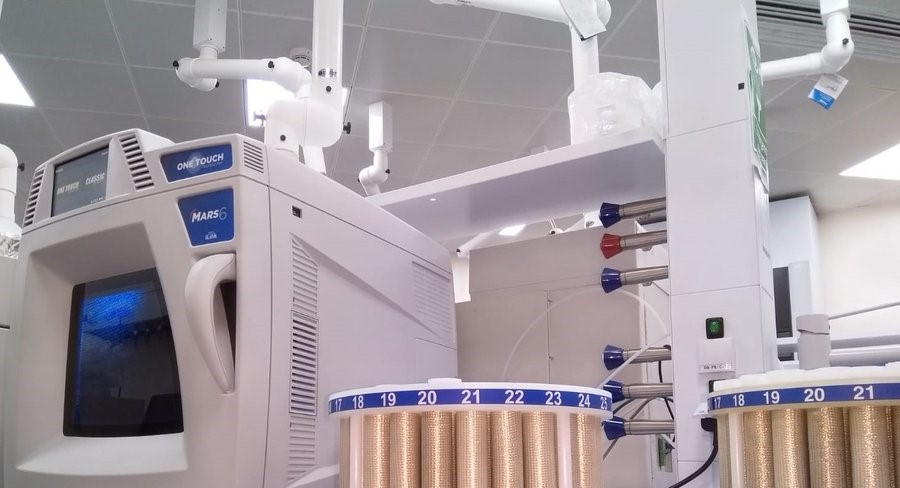
Microwave digestion is an established technique that has been used for many years. Sample digestions are used to suspend samples in the liquid phase, as this facilitates trace metal analysis. Using a microwave digestion method provides two main benefits: Firstly, using microwave energy in a sealed vessel significantly increases the boiling point of an acid. This extra temperature means samples can be digested faster and more effectively. The other advantage is that it is impossible to completely digest some types of materials using just acids at atmospheric boiling points. In order to digest these types of materials, a higher temperature is necessary. Using the sealed container, as in microwave digestions, this is possible.
6.3.1.
Applications
- Sample preparation technique for metals, trace metals, and isotopic analysis in a different matrix.
- Applied to a broad range of samples including soils, plastics, oils, pharmaceuticals, metals mining, wastewater, consumer products, foods & feed, environmental samples, petro & energy industry, and many more.
Instrument |
Manufacture |
Model |
Location |
Person in charge |
Microwave Digestion System, One-Touch Technology |
CEM Corporation |
MARS 6 |
BCR Building - Corridor 4 - D116 |
Dr. Mohammad Ibrahim Ahmad Research Associate
Mohammad.ibrahim@qu.edu.qa
4403 5716 |
Mr. Mohammad Sulaiman Lab Technician
msulaiman@qu.edu.qa 4403 3919 |
7. Nuclear Magnetic Resonance Laboratory (NMR)
NMR JEOL 600 MHz
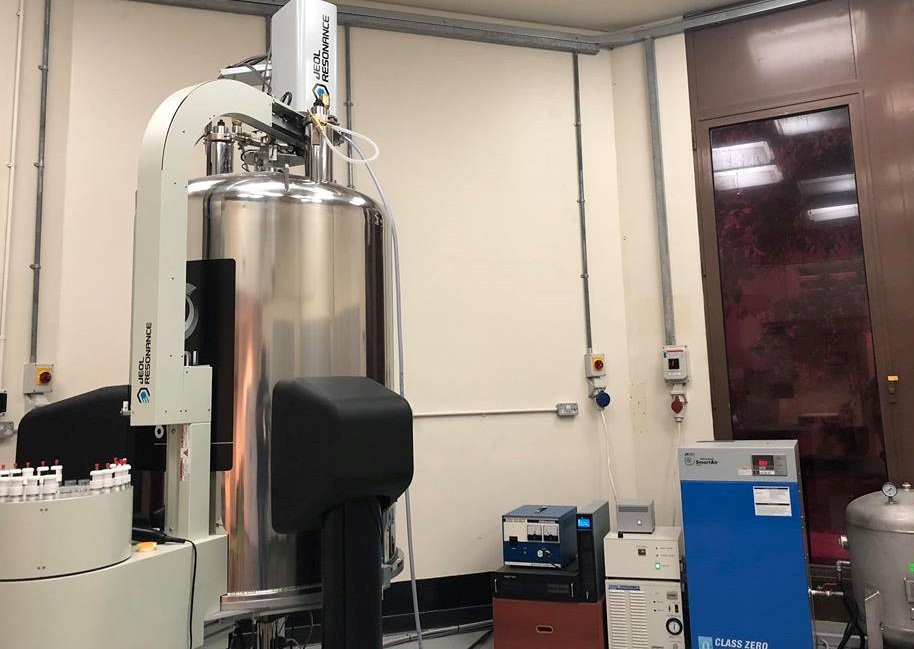
NMR spectrometer equipped with a broadband liquid probe, solid probe, and variable temperature (VT) unit. The NMR spectroscopy has become one of the essential and the most powerful analytical technologies in chemistry, especially in organic chemistry and organometallics, majorly for chemical structure identifications.
7.1.
Applications
- Determine the chemical synthesis and reaction monitoring.
- Determine the molecular structures and dynamics.
- Determine the molecular imaging.
- Determine the agriculture and food industry.
- Determine the polymers and solid materials.
- Determine the low-throughput ligand screening.
Instrument |
Manufacture |
Model |
Location |
Person in charge |
Nuclear Magnetic Resonance (NMR) |
JEOL |
JEOL 600 MHz |
BCR Building - Corridor 3 - C115 |
Dr. Haw-Lih Su Research Associate
hsu@qu.edu.qa
4403 6776 |
Eng. Sherin Abdel Fatah Lab Technician
Sherin.a@qu.edu.qa
4403 3936 |
8. Liquid Nitrogen Generator
Cryogenic Liquid Nitrogen Generator LN2G
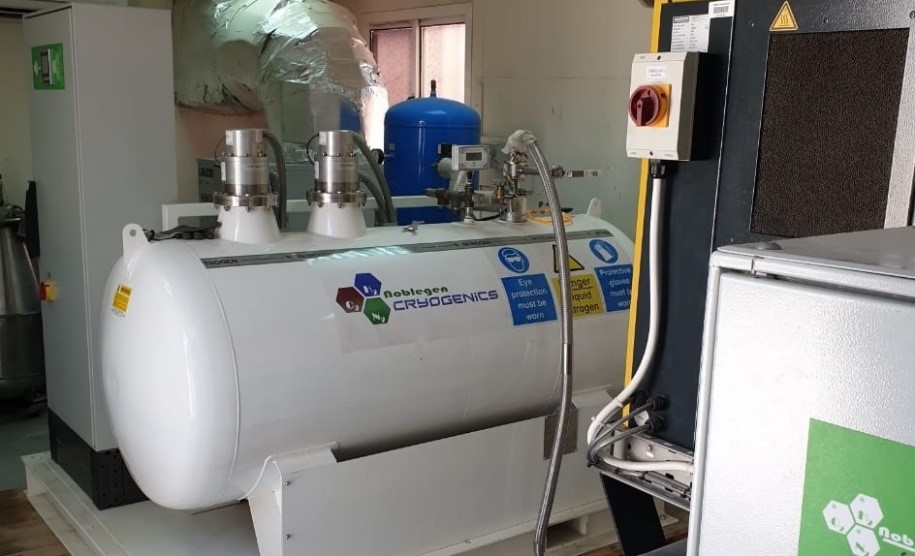
An oil-free air compressor, internal PSA nitrogen generator combined with a Cryo-cooler, helium compressor, and internal Dewar all controlled through a color graphic HMI touch-screen and in-house designed control software gives a fully automated system at the touch of a button.
8.1.
Applications
- The freezing and transporting of food products
- The cryopreservation of biological samples, such as sperm, eggs, and animal genetic samples
- Use as a coolant for superconductors, vacuum pumps, and other materials and equipment
- Use in cryotherapy to remove skin abnormalities
- The shielding of materials from oxygen exposure
- The quick freezing of water or pipes allow work on them
- A source of extremely dry nitrogen gas
- The molecular gastronomy preparation of unusual foods
- The cooling of materials for easier machining or fracturing
- Science projects, including making liquid nitrogen ice cream, creating nitrogen fog, and flash-freezing flowers and subsequently watching them shatter when tapped onto a hard surface.
Instrument |
Manufacture |
Model |
Location |
Person in charge |
Liquid Nitrogen Generator LN2G |
Noblegen Cryogenics |
LN130 |
Chemical Store Building |
Mr. Tageldin Elkhatat Laboratories Coordinator
tageldin.elkhatat@qu.edu.qa
4403 7397 |
Dr. Ahmed Easa Lab Technician
ahmedaali@qu.edu.qa
4403 6782 |
Spectroscopy the use of spectroscopes to analyze spectra More (Definitions, Synonyms, Translation)
Chromatography a process used for separating mixtures by virtue of differences in absorbency More (Definitions, Synonyms, Translation)